The resplendent hellebore blossoms are renowned for their vibrant and captivating nature, adorning the late winter and early spring seasons with their cup-shaped allure. Known as Lenten roses or winter roses, these perennial plants are a magnificent fusion of Helleborus orientalis and various hellebore species, resulting in a dazzling array of colors such as pink, red, peach, purple, green, and rose.
Lenten rose flowers hold a special place among the most coveted ornamental perennials, particularly in shaded garden landscapes. These lush plants, with their colorful blooms, effortlessly thrive in diverse climates and are a delight to cultivate. Moreover, they exhibit a remarkable resilience to frost and are resistant to the nibbles of deer and rabbits, with some varieties retaining their foliage throughout the year.
This article serves as a comprehensive guide to identifying the most captivating hellebore flowers, while also providing insight into the myriad Lenten rose hybrids and their application in garden landscapes.
Hellebore Flowers
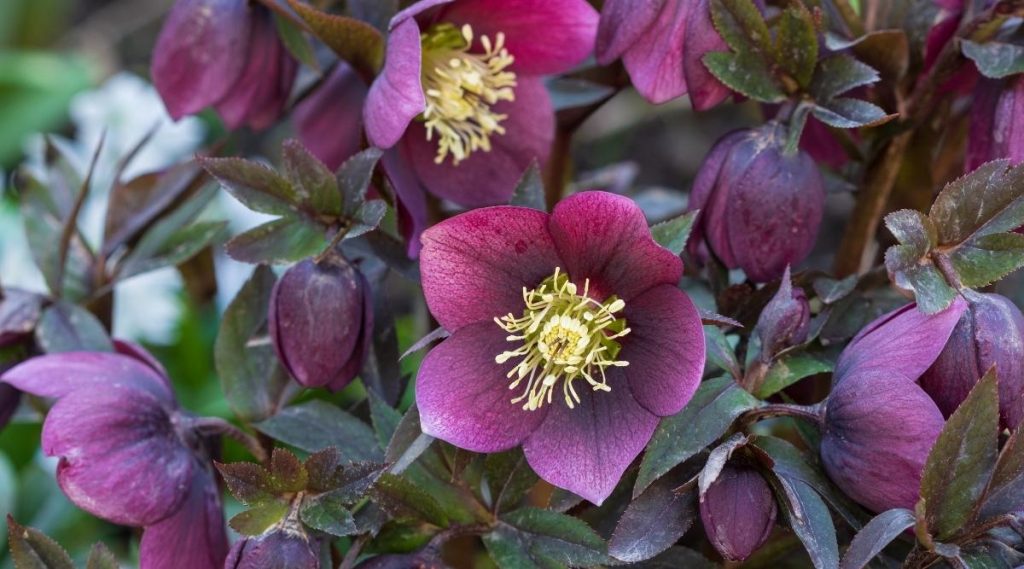
Hellebore flowers possess a diverse color palette, ranging from single to double blooms
The hellebore hybrids boast stunning cup-shaped flowers that elegantly grace upright stems. These exquisite blooms can manifest as single or double blossoms, each consisting of five rounded or pointed petals with a smooth or delicately frilled appearance. These breathtaking flowers measure between 2 to 3 inches (5 – 7.5 cm) in diameter.
With five overlapping petals encircling a crown of yellow stamens, the flowers adopt a graceful bowl or nodding form.
Lenten rose flowers flourish from late November until April, serving as a harbinger of the upcoming spring. Their striking hues of pink, red, purple, peach, and white grace the landscape for a remarkable span of six to eight weeks.
As perennial plants, hellebores provide enduring beauty year after year, requiring minimal maintenance. These bushy plants persistently bloom, enlivening winter landscapes with vibrant colors and ornamental grandeur.
Despite the common moniker of Lenten roses, hellebore hybrid plants are unrelated to true roses. The nomenclature stems from their blooming period during late winter and early spring. The rose-like buds that precede the emergence of these splendid flowers further contribute to their name.
Hellebore Leaves

Hellebore leaves feature serrated margins, adding to their distinctiveness
Hellebore plants present evergreen broadleaf perennials characterized by large, stiff, glossy, and leathery leaves. These enduring compound leaves typically comprise seven to nine leaflets, forming an umbrella-like arrangement. Each leaflet exhibits serrated margins and an elongated oval shape. Thanks to their evergreen foliage, Lenten roses retain their dark green hue throughout winter.
In colder climates, these shrub-like plants may display semi-evergreen tendencies.
Hellebore Identification
Identification of hellebore plants revolves around the presence of vibrant, showy cup-shaped flowers nodding gracefully atop upright stems. Typically, three or four blossoms adorn a single stem. Furthermore, the garden landscaping plant showcases palmately compound large evergreen leaves. Lenten roses thrive as clumping bushy plants, reaching a height and width of 2 feet (0.6 m).
Hellebore plants (Helleborus spp.) are low-growing evergreen and semi-evergreen perennials belonging to the buttercup family Ranunculaceae. In warmer climates, these flowering plants retain their colors year-round. However, in colder regions, these hardy plants recede during winter, only to resurface in late winter.
It is crucial to note that all parts of hellebore plants contain toxins.
Ingesting the leaves, stems, or flowers can induce seizures and vomiting, while contact with the plant’s sap may irritate the skin.
Lenten Rose Varieties
Let us delve into a brief overview of remarkable Lenten rose varieties suitable for planting in USDA zones 4 to 9:
Double white picotee: This Lenten rose variety boasts double blooms with white petals, adorned with a deep pink border. Some variations showcase pointed petals with streaks or veins of pink.
Lenten rose ‘Ivory Prince’: This hellebore presents greenish to creamy white saucer-shaped flowers emerging from pink buds. Notably, the flowers face outward rather than nodding.
Lenten rose ‘Red Lady’: This hellebore cultivar showcases cup-shaped nodding blooms in hues ranging from deep red and cherry to nearly dark purple shades.
Black flowering hellebore: A captivating plant boasting black flowers featuring multiple rows of five almost black petals, contrasting beautifully with a central crown of white stamens.
Hellebore ‘Windcliff Double Pink’: This hybrid’s stunning flowers exhibit deep pink tones, interlaced with lighter pink mosaic-like patterns. These captivating blooms encircle a ring of vibrant yellow stamens.
How to Plant Hellebore
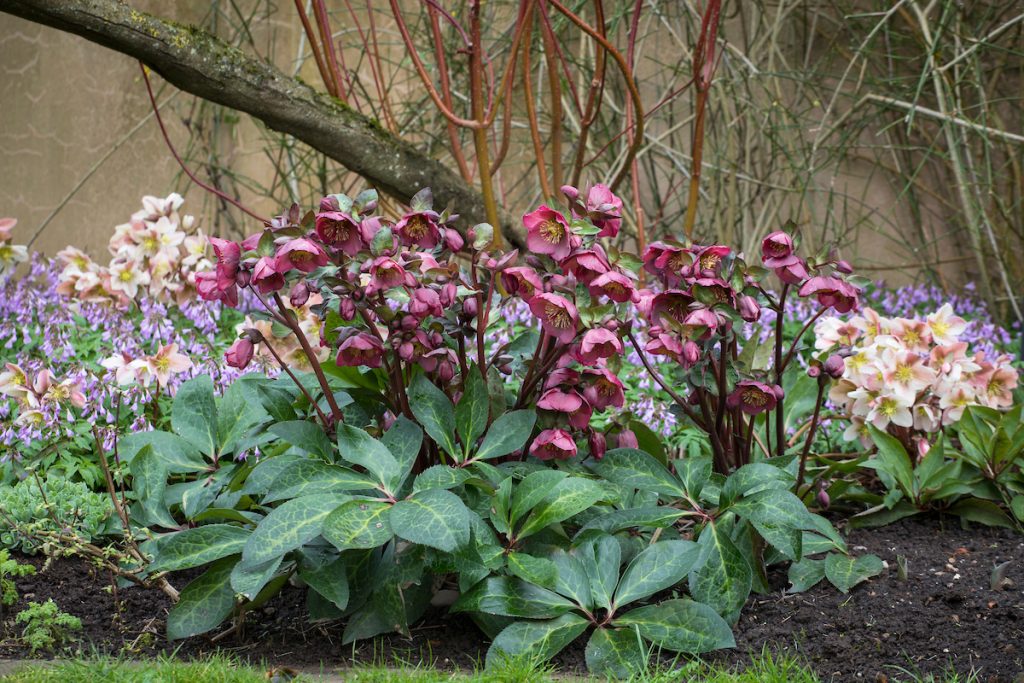
Cultivate hellebore flowers in well-draining, fertile soil within partially shaded areas
Hellebore flowers thrive in partially shaded environments during summer, although some variants can tolerate full shade. In winter, they benefit from increased sunlight while appreciating shelter from the intensity of midday sun. While hellebores can tolerate full sun, excessive heat may cause browning along the leaf edges.
Plant Lenten roses in fertile, humus-rich, and adequately drained soil. Ideally, position them in front of borders or beneath deciduous trees and shrubs, ensuring they receive sufficient sun exposure during winter. Hellebores flourish within USDA zones 4 to 9.
As with all flowering evergreen perennials, hellebores return year after year. To facilitate successful planting of Lenten roses, consider the following helpful tips:
Choosing the planting location: Hellebore plants can be planted at any time of the year, provided the ground is not frozen. Select a spot with partial shade and excellent drainage. Additionally, ensure the plants receive some protection from the intensity of summer midday sun.
Preparing the soil: Prior to transferring hellebores to the ground, enrich the soil with organic matter and compost to enhance nutrient levels.
Planting hellebores in the ground: Begin by digging a hole that matches the depth of the root ball and is twice as wide. Ensure the plant is positioned at the same depth as its pot, with the crown slightly above soil level. Space the plants around 15 inches (38 cm) apart. Before placing the root ball in the hole, gently loosen the roots. Proceed to backfill the hole, firmly tamping down the soil as you go. Finally, thoroughly water the area.
How to Care for Hellebore
Lenten roses are relatively low-maintenance ornamental plants, perfect for shaded areas in the garden. For optimal blooming, hellebores thrive when the soil remains consistently moist but never waterlogged. In the absence of rain, provide approximately one inch (2.5 cm) of water per week. During summer, ensure the plants receive shade or dappled sunlight, protecting them from direct exposure to the sun.
To encourage healthy blooms and an abundance of flowers, hellebores benefit from the presence of organic matter. Therefore, consider adding compost to the root area in late fall, once a year. If you have a large number of plants, employing a balanced slow-release fertilizer designed for flowering plants can be beneficial.
Pruning the plants once a year is an essential aspect of hellebore care. This involves trimming back the large, leathery leaves as new foliage emerges and the plant begins to bloom.
Types of Hellebore Flowers (Lenten Rose) With Pictures
Hellebore flowers serve various purposes within the landscape. Thriving in partial to complete shade, these ornamental plants are ideal for shaded borders, under large shrubs, or within woodland gardens. Thanks to their glossy evergreen leaves and winter-to-spring blooming habit, these low-growing perennials provide year-round interest in any landscape.
Now, let us explore some of the most exceptional Lenten rose flowers suitable for your front or backyard:
Hellebore ‘Double Pink’ Flowers
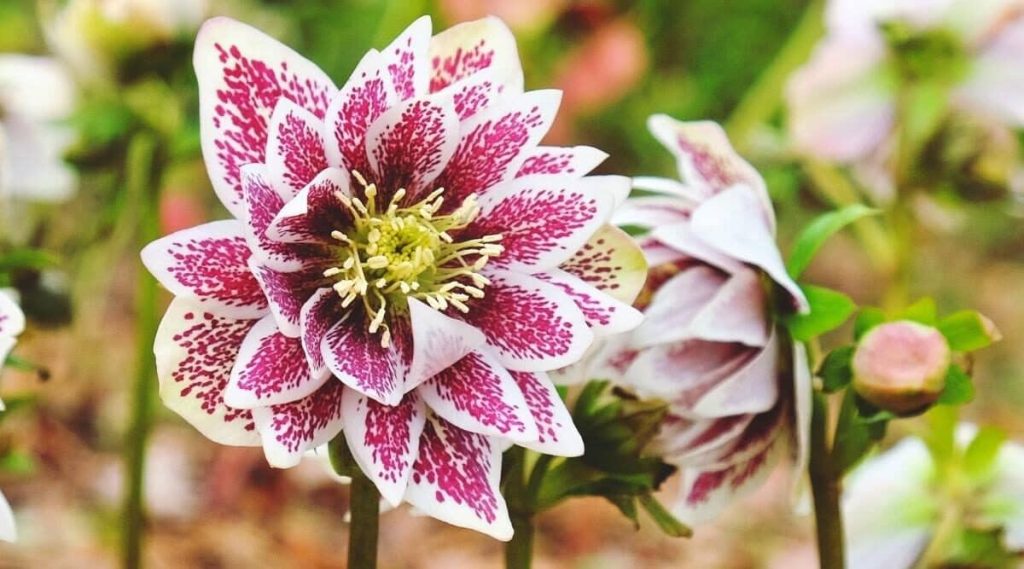
The flower colors of ‘Double Pink’ hellebore cultivars vary significantly, with some exhibiting darker shades than others
‘Double Pink’ hellebores captivate with their profusion of stunning pink flowers, ranging from dark to pale hues, which gracefully nod over the clumping plant. These showy double blooms consist of rows of ruffled petals forming a compact cup shape. Blooming from late winter to early spring, these vibrant pink flowers bring a burst of color to the barren winter landscape.
Helleborus × hybridus ‘Mrs Betty Ranicar’
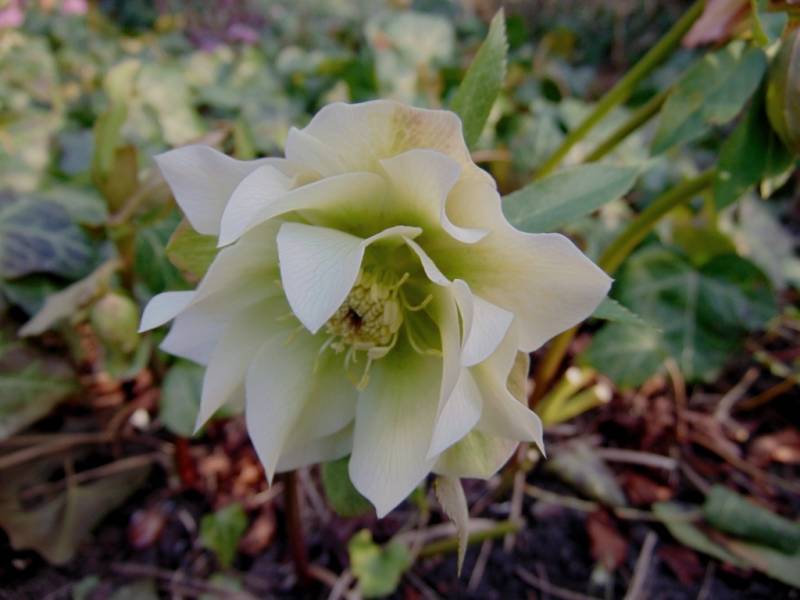
Helleborus × hybridus ‘Mrs Betty Ranicar’ features fully double white flowers
‘Mrs Betty Ranicar’ Lenten rose produces pure white flowers with fully doubled petals. The pointed white petals converge to create an elegant cup shape, gracefully nodding at the end of erect stems. These immaculate white double blooms contrast beautifully with the plant’s leathery evergreen leaves.
This mounding evergreen perennial reaches a height and width of 16 to 30 inches (40 – 60 cm) and is suitable for containers, foundations, borders, or as an understory flowering plant.
Lenten Rose ‘Pink Lady’
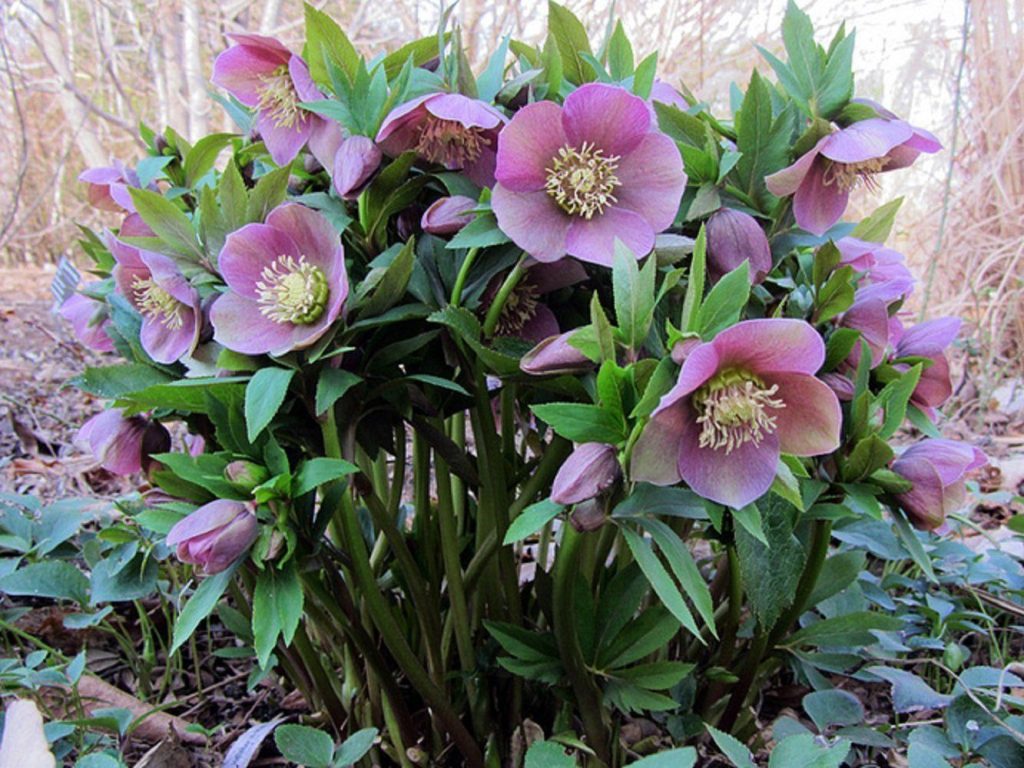
Lenten Rose ‘Pink Lady’
‘Pink Lady’ hybrid hellebore presents a spring-blooming variety with shades ranging from pink to rose. These Lenten rose flowers showcase speckled patterns within the flower cup, accompanied by vibrant yellow stamens. These charming pink flowers nod gracefully at the tips of the stems.
‘Pink Lady’ clumping perennials grow 12 to 18 inches (30 – 45 cm) tall and 18 to 23 inches (45 – 60 cm) wide. Their deep green foliage, varying from light to dark pink flowers, and bushy appearance contribute to their allure as a captivating landscaping plant.
Lenten Rose ‘Red Lady’

Lenten Rose ‘Red Lady’
As part of the ‘Lady’ series, this flowering evergreen plant boasts single blossoms in shades of cherry red to dark crimson, occasionally embellished with darker blotches. Like most hellebores, the flowers possess a cup-shaped form, a compact structure, and a nodding orientation. These enduring landscaping plants bloom for two months, from late winter to spring.
Black Flowering Hellebore
Several extraordinary hellebore plants showcase deep purple petals that create the illusion of black. Alongside their purple foliage, these captivating shrub-like plants offer a visual feast within the landscape. The black-flowering Lenten rose can manifest as single or double-blooming varieties.
Helleborus orientalis ‘Ruse Black’
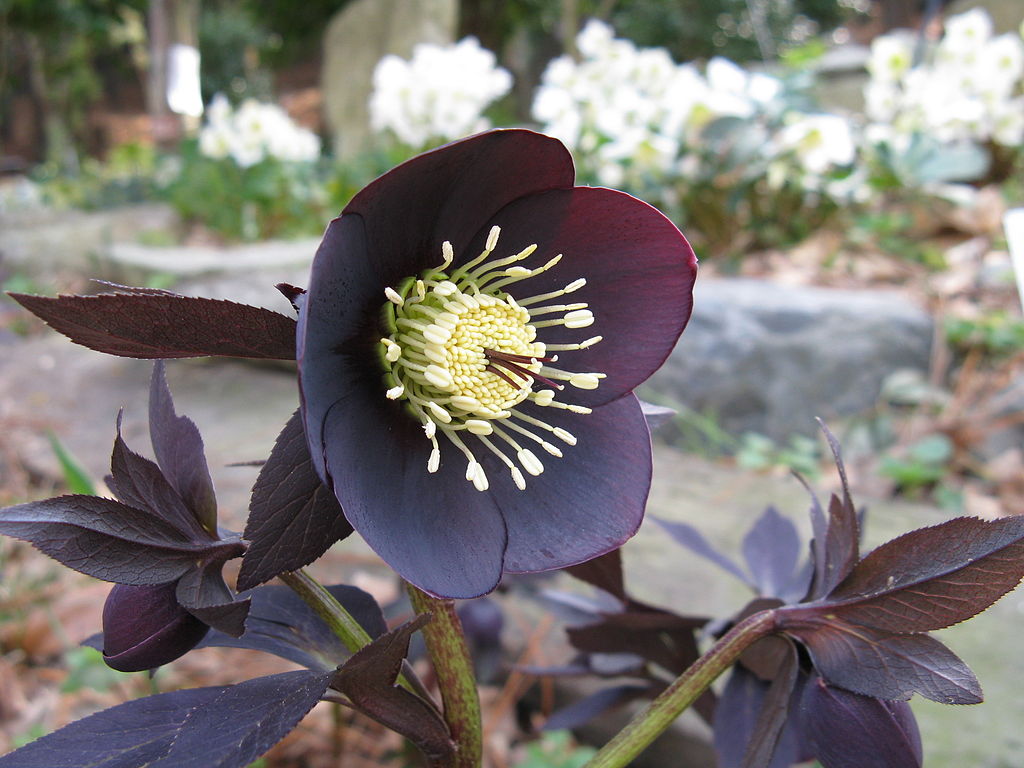
Helleborus orientalis ‘Ruse Black’
The ‘Ruse Black’ hellebore boasts cup-shaped flowers in a deep blackish-purple hue, enhanced by tufts of white stamens at the center. In addition to the single black flowers, this mounding perennial features clumps of thick, leathery, evergreen lance-shaped leaves.
Hellebore ‘Double Black’
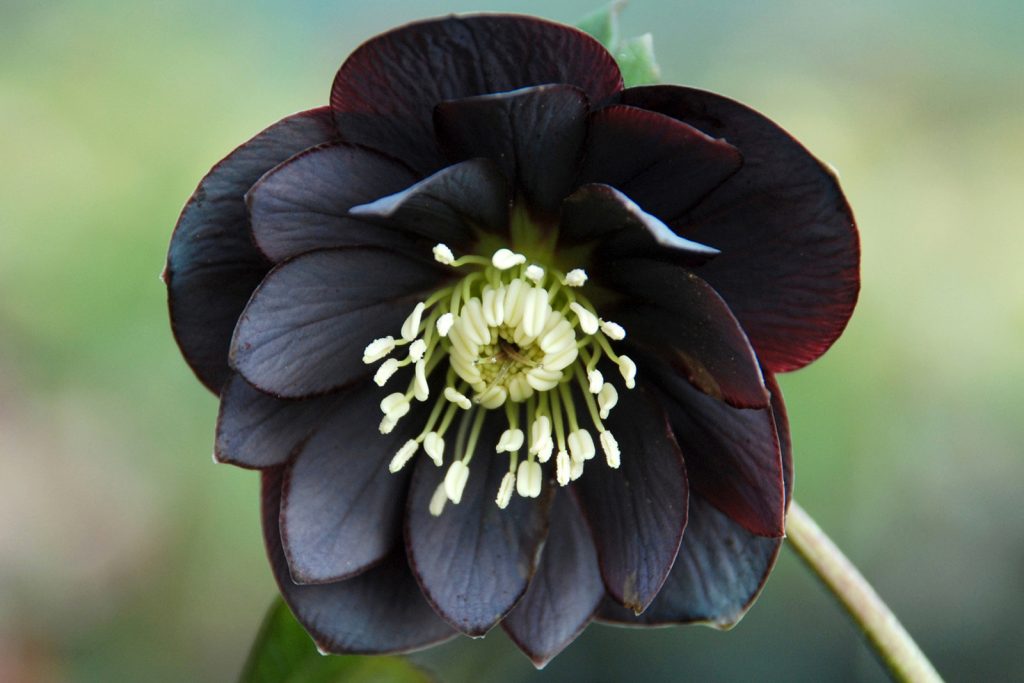
Hellebore ‘Double Black’
The ‘Double Black’ hellebore hybrid dazzles with its showy black flowers, showcasing several rows of deep purple, almost black petals. These oval-shaped petals possess pronounced tips, adding to the visual allure of these dark blooms that emerge during late winter and early spring.
Hellebore Ivory Prince (Helleborus niger ‘Ivory Prince’)
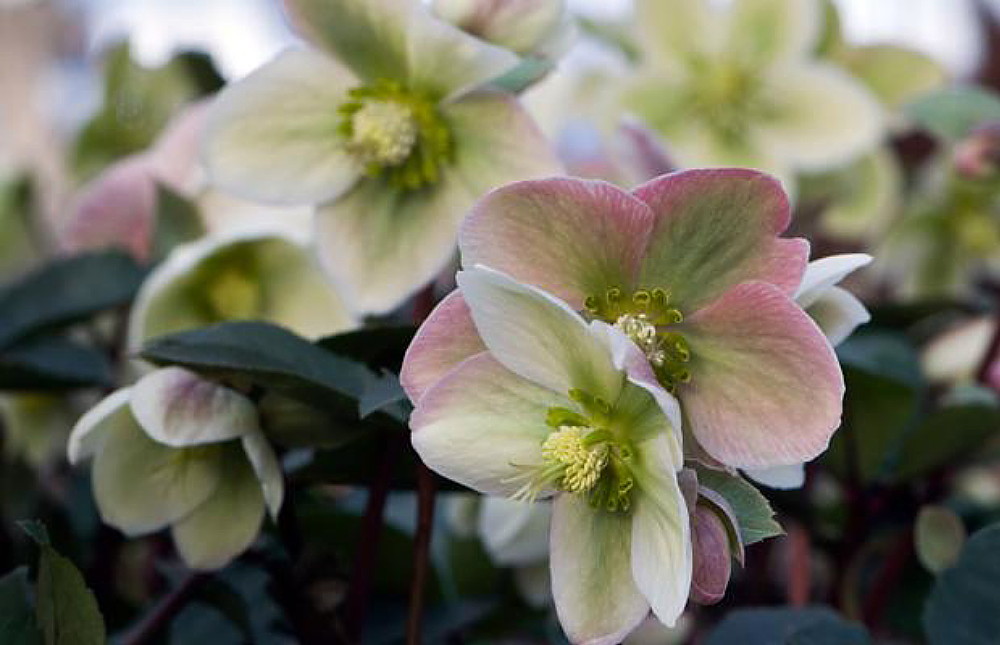
Hellebore ‘Ivory Prince’ (Helleborus niger ‘Ivory Prince’)
Also known as the Christmas rose, ‘Ivory Prince’ hellebore exhibits flat, upright creamy white flowers emerging from burgundy-pink buds. The profusion of creamy white flowers ascends on reddish stems, measuring 2 to 3 inches (5 – 7.5 cm) in width. As the flowers mature, they transform into chartreuse hues. Unlike most Lenten rose flowers, the blooms face outward, further accentuating their elegance.
Like all hellebore varieties, the bushy clumps of ‘Ivory Prince’ thrive in shade gardens, adding splendor beneath the shade of towering trees and shrubs. They also serve as ideal container plants for patios. Planting these creamy white hellebore flowers in groups enhances their visual impact.
Green Flowering Hellebore (Helleborus viridis)

Green flowering hellebore (Helleborus viridis)
Green hellebore flowers exude a unique charm within the botanical realm. These nodding cup-shaped single flowers can display the same verdant hues as their leaves. Green hellebore plants boast lance-shaped leaves with distinctively jagged margins. The green flowers consist of five large sepals, making their appearance from February to April.
Green hellebore flowers possess an open cup shape, measuring 1.6 to 2 inches (4 – 5 cm) in diameter. Although native to certain European countries, the green hellebore has become invasive in various parts of North America. This green-flowering plant is also referred to as boar’s foot or bear’s foot.
Hellebore ‘Candy Love’ (Helleborus x ballardiae ‘Candy Love’)
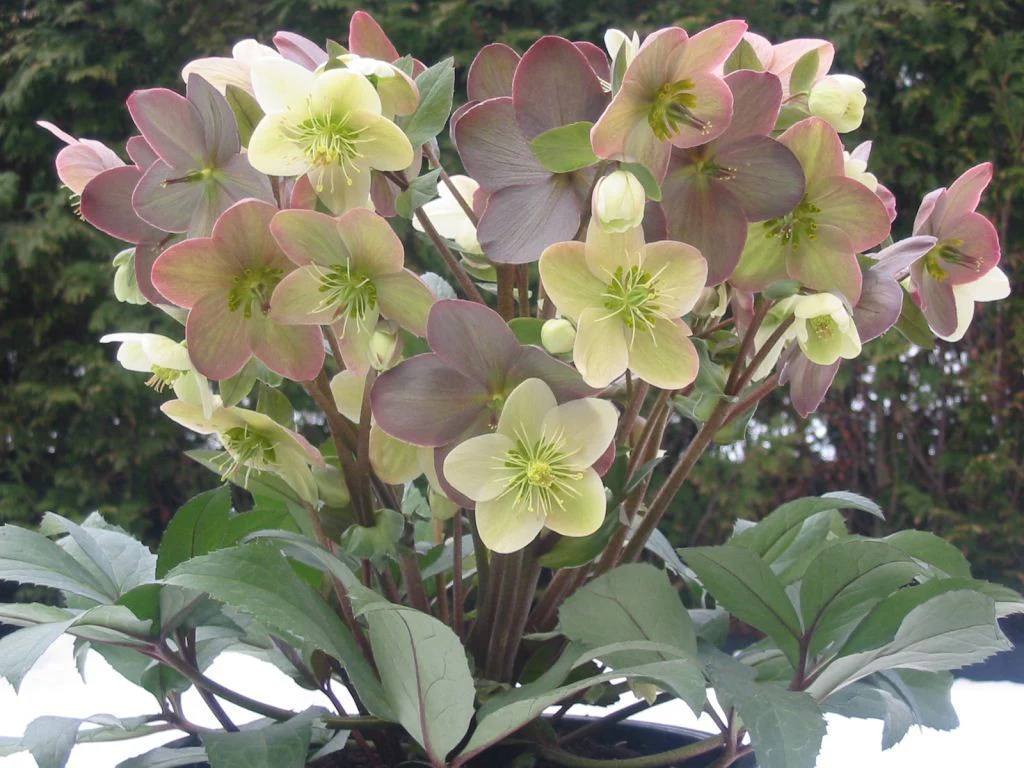
Hellebore ‘Candy Love’ (Helleborus x ballardiae ‘Candy Love’)
The ‘Candy Love’ hellebore hybrid boasts an abundance of large, saucer-shaped white flowers tinged with pink. These eye-catching blooms measure approximately 3.5 inches (8 cm) in width and feature an open-faced structure rather than a cup shape. The star-shaped white-pinkish flowers boast a cluster of green and yellow stamens at their center. This hellebore cultivar blooms profusely for several weeks.
The outward-facing white starry flowers exude a captivating charm and persist on this robust plant. The ‘Candy Love’ hellebore grows as a bushy clump, with upright stems reaching 12 to 15 inches (30 – 37 cm) in height and spreading up to 18 inches (45 cm) wide.
These radiant hellebore flowers are perfect for illuminating shaded gardens while providing early pollinators with nectar during their abundant late-winter blooms.
Helleborus × hybridus ‘Double White Picotee’
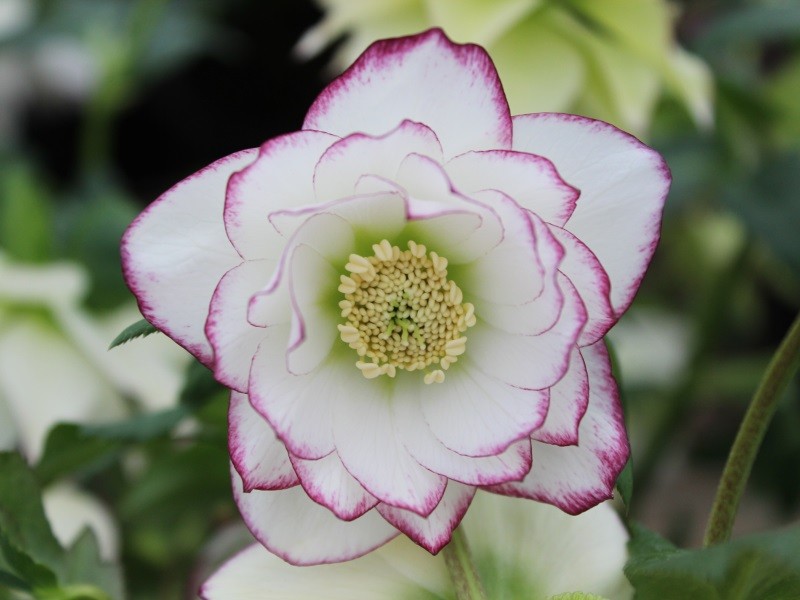
Helleborus × hybridus
‘Double White Picotee’
The ‘Double White Picotee’ hellebore variety enchants with its spectacular show of double flowers. These blossoms feature ruffled petals with purple-pink edges, forming a compact cup shape. The brilliantly colored white flowers, measuring 3 inches (7.5 cm) in diameter, contrast beautifully with the clumps of dark-green foliage characterized by leathery, deeply-lobed leaves.
